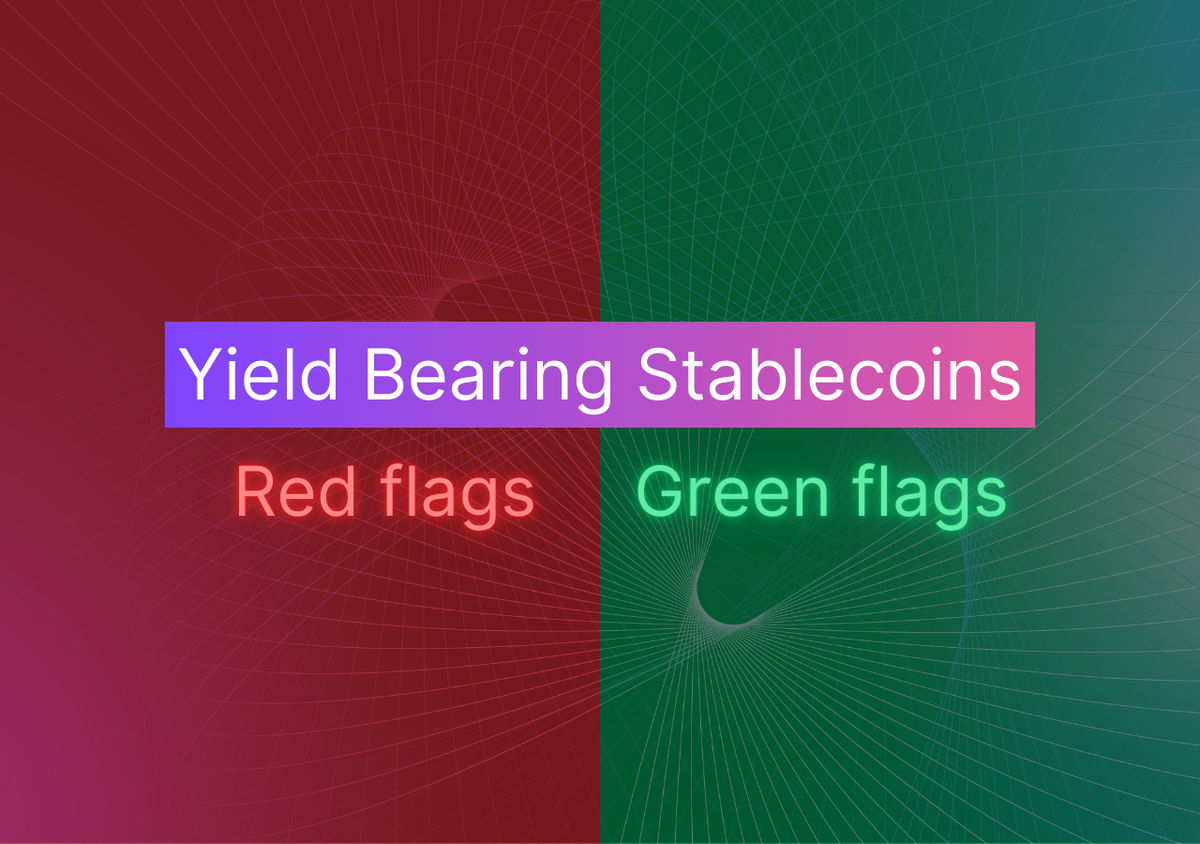Red Flags & Green Flags to Spot Safe Yield-Bearing Stablecoins

Source: Red Flags and Green Flags of Yield Bearing Stablecoins | composable-security.com
Yield bearing stablecoins aim to maintain a stable peg to fiat currencies while generating yield from lending, staking, or real-world assets. Because they promise both stability and returns, careful scrutiny is essential to ensure their safety and sustainability.
What to Look For: Green Flags
These indicators help you identify trustworthy yield bearing stablecoins by checking transparency, security, and clarity.
1. Clear, Specific Yield Sources
- Why: Knowing exactly where returns come from confirms if they are sustainable.
- Check: Look for “How it works” or “Strategy” pages showing assets or protocols involved, with inspectable addresses.
2. Transparent Reserve Data
- Why: Reserves backing circulating supply prove solvency.
- Check: Public reserve info should be verifiable on-chain by comparing asset balances to total token supply.
3. Multiple, Detailed Security Audits
- Why: Diverse audits catch broader risks; clear issue tracking shows commitment to fixes.
- Check: Audit reports should be recent, public, and have findings marked as fixed or acknowledged.
4. Clear Redemption Rules and Fees
- Why: Reliable redemption protects the peg during market stress.
- Check: Websites should publish who can redeem, fees, and settlement timeframes; verify recent on-chain redemptions.
5. Diversified, Organic Liquidity
- Why: Liquid markets on multiple exchanges prevent slippage and peg breaks.
- Check: Verify liquidity pools’ TVL and volume on DEXes and at least one reputable centralized exchange.
6. Detailed Risk Disclosures
- Why: Explicit risks demonstrate maturity and preparedness.
- Check: Find “Risk” or “Disclosure” sections outlining specific threats.
7. Independent Analytics & Historical Data
- Why: Third-party dashboards provide unbiased insights into yield paid, TVL trends, and holder distribution.
- Check: Use dashboards like Stablewatch and cross-verify dates and data on-chain.
8. Visible, Accountable Team
- Why: Identifiable team members improve trust and governance accountability.
- Check: Look for full names, roles, LinkedIn/GitHub profiles, and legal entities; governance multisigs should match disclosed team members.
What to Avoid: Red Flags
Watch out for these warning signs that often point to hidden risks or poor project hygiene.
1. Unclear or Changing Yield Explanations
- Why: Vague claims like “AI trading” or “advanced strategies” without specifics obscure true risk.
- Check: Absence of concrete partner details or on-chain addresses is suspicious.
2. No Public or Mismatched Reserve Data
- Why: If reserves can’t be reconciled with supply, solvency is uncertain.
- Check: Missing or inconsistent on-chain reserve info is a concern.
3. Unlimited or Opaque Minting Authority
- Why: Unrestricted minting risks inflation and peg failure.
- Check: Inspect contract roles; single addresses with mint power and no multisig/timelock is risky.
4. Centralized Pause or Kill-switch Without Transparency
- Why: Arbitrary freezes can harm users if policies aren’t published.
- Check: Identify pause/blacklist calls and who controls them; beware if no usage policies exist.
5. Old, Shallow, or One-off Audits
- Why: Outdated audits may miss new vulnerabilities.
- Check: Confirm audit dates, scope, and if exact deployed contracts were assessed.
6. Concentrated Reserve Exposure
- Why: Heavy reliance on one custodian, borrower, or protocol exposes reserves to single points of failure.
- Check: Review asset distribution on-chain.
7. Complicated or Restricted Redemption Policies
- Why: Frequent redemption pauses or long lockups signal fragile peg.
- Check: Look for redemption gating in terms or past announcements; check on-chain redemption activity.
8. Suspicious or Incomplete Project History
- Why: No verifiable past yield or unexplained migrations reduce trust.
- Check: Independent dashboards should show yield paid (YPO), stable supply history, and no sudden suspicious events.
9. Anonymous or Hidden Team
- Why: Lack of transparency reduces accountability and increases risk.
- Check: Absence of public team identities, unverifiable contact info, and mismatched governance keys are warning signs.
Bottom Line
Yield bearing stablecoins combine the challenge of holding a peg with investment risks. Always verify:
- Reserve transparency and supply reconciliation
- Verified, audited code and multisig governance
- Specific, diversified, documented yield sources
- Clear, consistently honored redemption terms
If multiple green flags align and red flags are absent, the project likely presents clearer (though not eliminated) risks. When key information is missing or unverifiable, approach with caution.
In Web3, independent validation outweighs bold promises.


